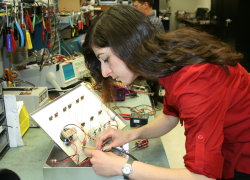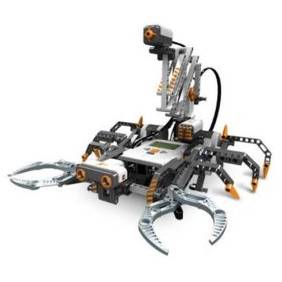Ask Donna Video: Girls and Robotic Teams
Hi, it’s Donna here with a new *Ask Donna* video blog,
In this week’s video, I advise a school on how to close the leaky pipeline of girls on robotics teams:
This week’s question comes from Vicki Mazur, Math/Computer Science Teacher at Classical Academy:
“Good morning Donna, I am mentoring 3 levels of competitive robotics; elementary, middle school, and high school. The elementary team averages 1/3 girls. The middle school team averages 1/4 girls. The high school team averages 1/5 girls.
While some of this “attrition” results from additional boys joining the teams, some of it is losing girls as other opportunities for extra-curricular activities increase.
This year, the high school team was initiated by 3 girls and 2 of them chose other avenues of afterschool activities. Two other girls replaced them so the final enrollment was 3 girls and 15 boys. The team, as a first-year competitor, placed 10th out of 75 in the region. Even with that success, enrollment for next fall looks to be more boys.
How do I increase attraction to the team when faced with the numerous non-STEM opportunities available to students in middle and high school?”
Watch this latest *Ask Donna* video to hear 4 things you can do to attract girls to STEM opportunities such as these robotics teams!
Then, Talk with Donna 1-on-1 in a Women in STEM & CTE More Information Session: Sign up for a free call to talk with Donna about your college’s STEM/CTE programs and specific challenges.
The *Ask Donna* WomenTech Educators Video Blog: Have questions about how you can see more women and girls in your STEM/CTE courses? Need help overcoming a recruitment or retention challenge specific to your program and school? Now is your chance to get your question answered in a personal video from Donna Milgram—IWITTS Executive Director and developer of the WomenTech Educators Training System—in this new monthly video blog. Answering questions is Donna’s favorite part of providing professional development to help educators move the needle for women in STEM and CTE.
Want Donna to answer your question in the next *Ask Donna* video blog? Donna’s coaching is usually limited to WomenTech Educators Training school teams, so don’t miss this opportunity to *Ask Donna* your questions on broadening participation.
Ask Donna – Submit a Question Now
Stay tuned for a new *Ask Donna* video blog!

 Instructors, administrators and counselors from the eight California community colleges involved in the CalWomenTech Project came together a couple of weeks ago to share their successes recruiting and retaining women to targeted technology programs and to problem solve as a group to overcome key challenges they are encountering. One of the issues is the current economic situation in California, which seemed relevant to our audience across the country, and so I wanted to share some of the great solutions our colleges came up with:
Instructors, administrators and counselors from the eight California community colleges involved in the CalWomenTech Project came together a couple of weeks ago to share their successes recruiting and retaining women to targeted technology programs and to problem solve as a group to overcome key challenges they are encountering. One of the issues is the current economic situation in California, which seemed relevant to our audience across the country, and so I wanted to share some of the great solutions our colleges came up with: See Wechie’s Comment of 8/21: There seems to be hundreds of separate initiatives to encourage girls to study computer science but there remains an image problem. How can we get an industry wide campaign going to improve the image of computing?
See Wechie’s Comment of 8/21: There seems to be hundreds of separate initiatives to encourage girls to study computer science but there remains an image problem. How can we get an industry wide campaign going to improve the image of computing? Recruiting 101: The key to recruiting women and girls in a field in which they are under-represented is female role models. You already know their numbers are small, so where do you find these women? IWITTS did a survey in 2005 and found that among educators word of mouth was the leading strategy (86%), followed by connecting with women on the street (66%). Respondents also found doing a newspaper story on their program effective! In addition, I’d recommend putting flyers up in your community saying you are looking for female role models in specific occupations.
Recruiting 101: The key to recruiting women and girls in a field in which they are under-represented is female role models. You already know their numbers are small, so where do you find these women? IWITTS did a survey in 2005 and found that among educators word of mouth was the leading strategy (86%), followed by connecting with women on the street (66%). Respondents also found doing a newspaper story on their program effective! In addition, I’d recommend putting flyers up in your community saying you are looking for female role models in specific occupations.
 I am happy to see that U Mass’s Computer Science (CS) Department added photos of women to its homepage. Out of seven photos–two now feature women! Unfortunately, the photos of women don’t show them working in the field with equipment as photos 1, 2 and 4 do for the males. The photos now show a woman writing on a board in a classroom setting and two women in an office setting. One of the recommendations IWITTS makes in our WomenTech training is that photos are taken of women working with equipment. Too often women are portrayed in “passive” roles in the workplace while males are in “active” roles.
I am happy to see that U Mass’s Computer Science (CS) Department added photos of women to its homepage. Out of seven photos–two now feature women! Unfortunately, the photos of women don’t show them working in the field with equipment as photos 1, 2 and 4 do for the males. The photos now show a woman writing on a board in a classroom setting and two women in an office setting. One of the recommendations IWITTS makes in our WomenTech training is that photos are taken of women working with equipment. Too often women are portrayed in “passive” roles in the workplace while males are in “active” roles.






Recent Comments